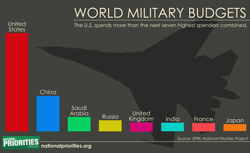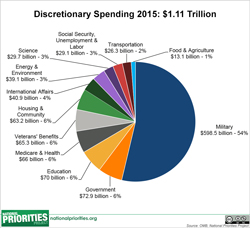
| Vol.
XXIX No.
4 March / April 2017 |
| contents |
| Printable Version |
Editorial
Trump’s Budget Cuts NIH, EPA, and Civilian Programs
to Fund Weapons Contracts and Foreign Wars
All the organizations of the scientific and academic communities have expressed grave concern over the budget cuts proposed by President Trump to the NIH, EPA, and related civilian agencies, as well as to the arts and humanities. Science Magazine (24 March 2017) detailed the overall problem for basic research. The New York Times, the Boston Globe, and other major news outlets echoed, in particular, the concern for the undermining of biomedical research. President Reif correctly pointed out in his March 27 letter that the proposed cuts would have a significant negative impact on MIT campus research activity. This comes on top of campus concern over the restriction on immigration and travel, addressed in the article by Prof. Rabbat in this issue.
The proposed effort to undermine the Affordable Care Act would have deprived millions of Americans of health care with current therapy and procedures. However, it left open advances in prevention, diagnosis, and treatment that would alleviate future ill health and disease. The proposed NIH cuts, if enacted, put such progress in grave danger. As has been pointed out in an op-ed in the NY Times (Osterholm and Olshaker, 24 March 2017) the proposed budget ignores non-military threats to our national security, such as continuing threats from infectious diseases.
The immediate impact of these cuts would be the defunding of graduate students, postdoctoral fellows, and research technicians here at MIT and at institutions throughout the country.
Unfortunately, very few of these analyses referred to above accurately describe the budget processes at work. The civilian programs were not cut to satisfy small government advocates; they were cut in order to finance the enormous $54 billion increase in Pentagon spending, including nuclear weapons modernization. The Pentagon budget was already some 54% of the entire Congressional discretionary budget last year. As the NY Times (March 16, 2017) stated clearly: “President Trump’s 2018 budget blueprint released on Thursday proposes cuts in discretionary spending for most government agencies to pay for large increases in military spending.” Budget Director Mulvaney was quite clear in speaking with Republican Governors: “By way of defending such extensive cuts, Mr. Mulvaney said simply that the White House’s priority was military spending and that other reductions were necessary to advance that goal.” (Alexander Burns, NY Times, March 22, 2017.)
The U.S. already spends more on the military than the next seven largest economies combined, including Russia (Figure 1). The proposed increase in U.S. Pentagon and weapons spending is on the order of the entire Russian military budget.

(click on image to enlarge)
The U.S. does not face invasion by hostile powers on either our northern or southern borders. Thousands of nuclear weapons on hair-trigger alert did not prevent terrorists from attacking Paris subways, Moscow theatres, or Middle Eastern mosques. Neither did they keep North Korea from proceeding with their nuclear weapons programs. The path to peace goes through diplomacy and economic and humanitarian aid – not President Trump waving nuclear swords of Damocles. This has been dramatically shown by the completion of the Iran treaty (in which MIT’s Prof. Moniz was instrumental).
The former Director of MIT’s Washington office, William Bonvillian, offers a detailed and informative review of federal budget policies, from a very different perspective than that offered here (see page 1). He focuses on the pressures for funding Social Security, Medicare, and other mandated programs. The pressure for increased military spending is given only a very minor role in the limiting effects on the civilian side. However, we note that Social Security and Medicare are trust funds, and not available for Congressional disposition, whereas NIH and Pentagon spending must come from income taxes through Congressional discretionary spending.
Rarely mentioned in this debate over budget priorities is the profitability of these investments. It is very difficult to extract significant corporate profits from public education, biomedical research, and environmental protection. In contrast, defense corporations are among the most profitable of American industries, reflecting preferential particularities in Pentagon contracts. A significant fraction of these billions of dollars will go to corporations in the form of monopoly contracts – since the contracts cannot be outsourced to the Chinese or Malaysian or Mexicans. The contracts are “cost plus,” with significant profit guaranteed above the actual costs of production, by Congressional mandate. Finally, many of these contracts are screened from standard government auditing by national security claims.
In assessing these differences, we find it perhaps most useful to present the federal budget in the pie chart below. If nothing else, at least this makes very clear how small a fraction of the overall budget science is (~3%), compared with the Pentagon budget (54%).

(click on image to enlarge)
Editorial Subcommittee
Aron Bernstein
Jonathan King
Ruth Perry
Nasser Rabbat
| Back to top | |
| Send your comments |
| home this issue archives editorial board contact us faculty website |